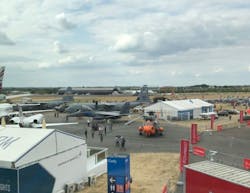Farnborough wrap-up: thoughts and impressions from the 2018 Farnborough International Airshow
FARNBOROUGH, England – Having spent the first three days at the Farnborough International Show, I met with interesting people from all over the world, sat in on various aerospace-focused educational sessions, and saw a number of breathtaking flying displays.
Having never been to the show before, I was a bit surprised at just how surprised I was at the sheer size and scope. Of course, I fully expected the show to be massive and full of people, I was just not mentally prepared for there to be such a gap in expectation and reality.
Upon entering the show for the first time, it took me a while to take everything in. Four large exhibition halls, tiered rows of private business chalets for industry heavyweights, and a field full of aircraft of all types, including airliners, jetfighters, helicopters, military transport aircraft, and more.
Right away, the flying demonstrations began. Of course, I had expected and anticipated these, but I didn’t realize I’d be so close to them. It would be a disservice to attempt to put into words how impressive they were, but I’m sure you could use your imagination to picture it.
From a business perspective, a few of the companies I met with reported that booth traffic, as well as business, was looking good. Stephen T. Sargeant, Major General, U.S. Air Force (Ret.), Chief Executive Officer, Marvin Test Solutions Inc., and Vice President, Strategic Development, The Marvin Group, for example, spoke to me about the rise of remotely-piloted aircraft and the opportunities this creates.
“RPAs [remotely-piloted aircraft] are appearing in all shapes, sizes, and capabilities,” he said. “Finally, multiple countries are embarking on designing these trainer and fighter aircraft. We’re excited about these observations because they will demand that the Marvin Group’s capability be brought to bear in many cases, providing armament and advanced test equipment capable of ensuring the most advanced systems are mission ready.”
Teledyne e2v also reported good news at the show, as the company announced that —in partnership with Surrey Satellite Technology Ltd. (SSTL) and the Centre for Electronic Imaging (CEI) at The Open University (OU)—it has been awarded a contract to develop CMOS TDI image sensors for small satellites for Earth Observation (EO). Under the contract, which was awarded by the UK Space Agency via the Centre for Earth Observation Instrumentation, Teledyne e2v will lead the development of new technology based on CMOS Time Delay and Integration image sensors.
"CMOS TDI sensors provide a smaller pixel running at higher speeds, which are suited ideally for smaller satellites,” said Paul Jerram, Chief Engineer, Space Imaging, Teledyne e2v on the tradeshow floor. “It’s virtually impossible to do this with CCDs, so we moved toward CMOS TDI. The CMOS TDI sensors offer on-chip digitization and operates at a lower voltage than CCDs.”
There were, of course, multiple massive deals and orders announced at the show, including those from Boeing,Airbus, Embraer, and so on. There was even a day where contracts landed totaled more than US $26.3 billion.
>>>View more information on the latest deals and news surrounding the airshow here.
Another theme I picked up during my visit to the show was excitement around some of the new technologies that were present. For example, RPAs—which Sargeant cited above—seemed to have a prominent presence. One such example was from a company from Portugal called Tekever, which designs RPAs for maritime surveillance.
To accomplish various maritime surveillance-related missions, Tekever combines and uses multiple sensors. Payload options include a five-sensor gyro-stabilized gimbal, multiple visual and infrared sensors, an automatic identification system (AIS), a maritime radar, and a synthetic aperture radar.
The Tekever UAV system also uses ground and onboard artificial intelligence (AI) algorithms for detection of objects such as oil spills. AI was another topic that came up from additional companies, including Mercury Systems and Daedalean. With Mercury Systems providing the hardware and Daedalean writing the software, these companies have collaborated to develop an AI system for autonomous flight control for the electric personal aircraft of the near future.
"People will have a much better idea of what AI can be used for soon," said Ike Song, Vice President, General Manager, Mercury Mission Systems. "All manner of missions are getting smarter and fully autonomous platforms, in both the commercial and defense domains are very close. All require massive on-platform processing capability and flight-safety certification."
In walking through each of the halls and through the grounds and working in the media center, it seemed as though people were really quite busy, which is ultimately one of the main points of the show. Hopefully everyone who attended—whether they were exhibiting, walking the floor, covering the event, hosting the event, etc.—were happy with the results. Overall, it was quite the experience, and one that I will never forget.
Pictured above: My view from where I wrote this.
View more Farnborough Airshow coverage here.
